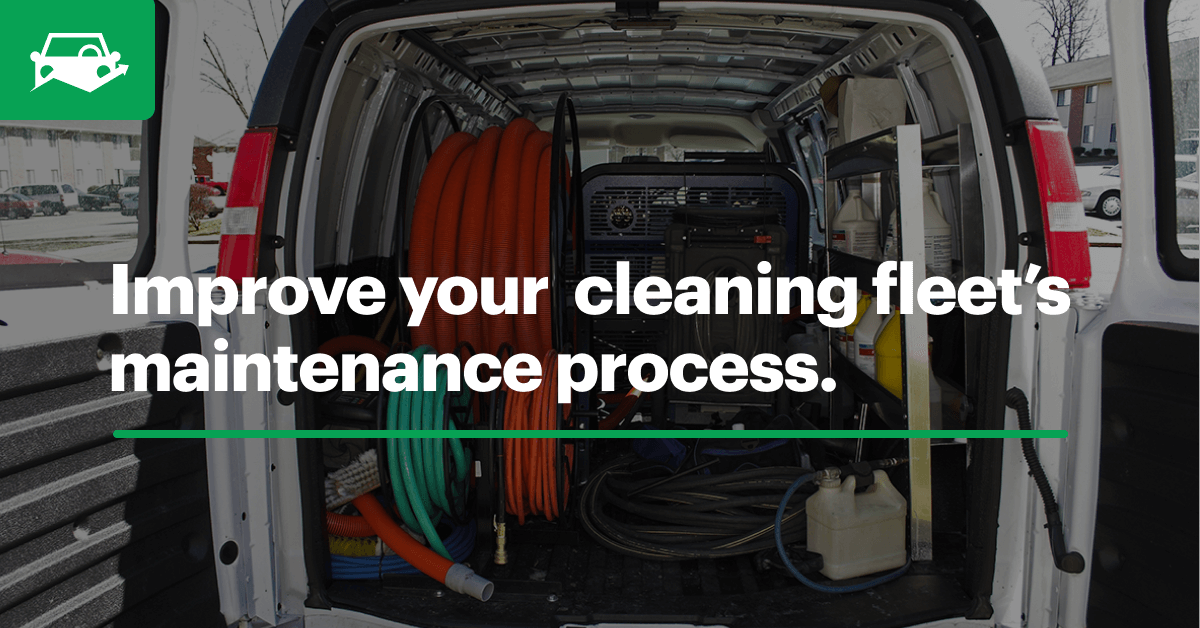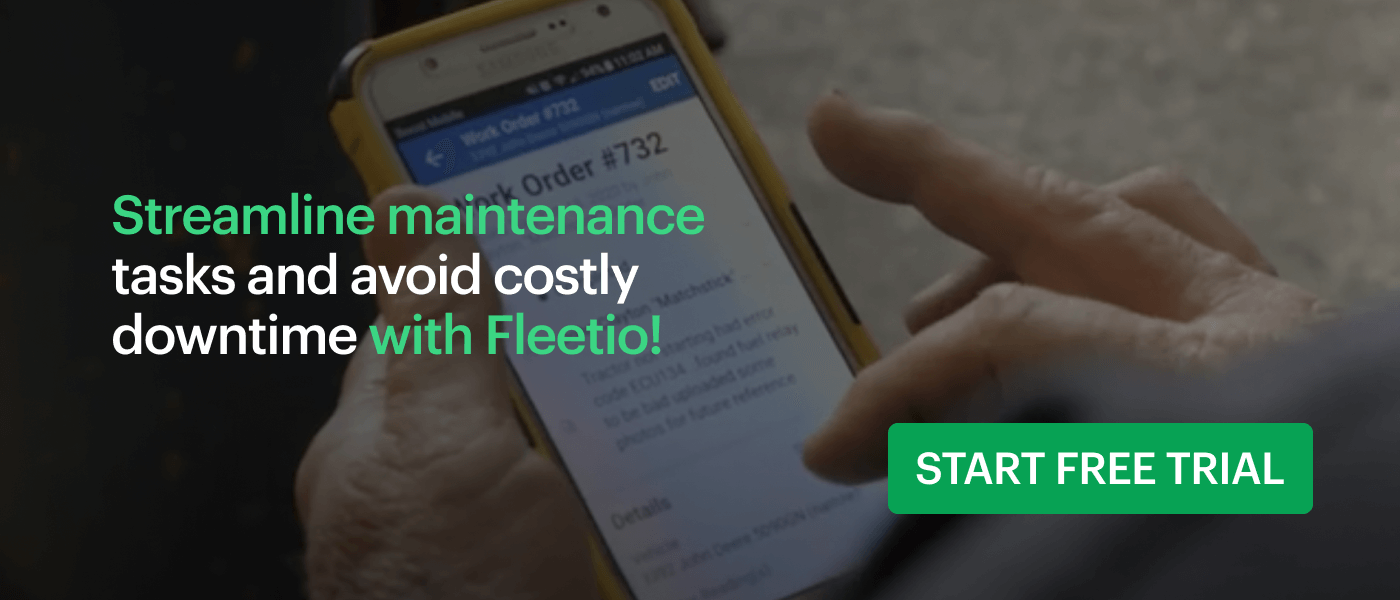With commercial cleaning vehicles and restoration fleets’ services in constant demand, vehicle uptime is critical. Leveraging a software solution to manage fleet maintenance enables you to create efficient repair workflows to help you avoid downtime and serve your customers.

This post was originally published in July 2020 and has been updated to ensure all content is current, relevant and accurate.
Restoration Fleet Maintenance Best Practices
Businesses with commercial cleaning vehicles or restoration fleets are heavily relied upon to provide fast, thorough service to clients in both commercial and residential spaces. Whether your restoration fleet is helping a business recover after a fire or flood, or your commercial cleaning vehicles are dispatched to sanitize areas due to COVID-19, time is of the essence.
Because you don’t have room for vehicle downtime in your schedule, it is imperative to effectively manage fleet maintenance and ensure all vehicles are in good condition before leaving for a job.
If you’re tracking your fleet’s maintenance with spreadsheets, digitizing that data in a cloud-based management software can help you avoid downtime, automate workflows and monitor expenses. By leveraging a centralized system, you can maximize visibility into asset health by receiving real-time updates from drivers via a mobile app.
Here are five tips to improve your cleaning or restoration fleet’s preventative maintenance (PM) strategy.
1. Leverage Electronic Vehicle Inspection Results
Monitoring fleet health can be a challenge when your vehicles are constantly in use. Having your drivers conduct daily vehicle inspections allows you to monitor asset health and be informed of issues quickly no matter where your vehicles are.
Many restoration fleets use paper inspection forms, which are frustrating to drivers and inefficient for quickly delivering results. Fleet managers may not be alerted to issues for days or weeks at a time, resulting in compounding issues and unexpected breakdowns.
Streamlining inspections and maintenance with a mobile fleet management app allows your drivers to complete simple, thorough inspections and upload results instantly. Fleet managers are immediately notified of any inspection failures, speeding up the workflow process.
Because commercial cleaning vehicles carry specialized equipment, paper inspection forms often aren’t useful for inspecting every aspect of your vehicle. Electronic vehicle inspections are configurable, allowing you to tailor forms to include items like:
-
Hoses
-
Vacuums
-
Shelving
-
Sanitization fluids
-
Batteries
-
Tires
-
Coupling devices
-
Brakes
-
Engine oil
-
Fuel tanks
2. Standardize PM Schedules
Restoration fleet managers know the importance of limiting downtime. When a client has water or fire damage, it is crucial to get to them as soon as possible to start recovery efforts.
Because you and your customers can’t afford unexpected breakdowns, all of your commercial cleaning vehicles should be following a PM schedule based on manufacturer recommendations. Adhering to a PM schedule ensures your vehicles are routinely serviced and remain in good condition to avoid downtime and maximize lifespan.
Fleet management software automates service reminders to improve your PM program. Service reminders are automatically sent based on odometer or usage updates from inspection results, preset OEM recommendations or telematics devices. These reminders provide you with ample time to schedule repairs around your team’s vehicle needs.
If your restoration fleet has a variety of commercial cleaning vehicles, creating and managing PM can be time-consuming. With Fleetio’s Service Programs, you can bulk manage maintenance tasks for multiple vehicles, enabling you to keep an organized schedule and eliminate hours of tedious data entry.
3. Streamline Maintenance Work Orders
Fleet managers spend a lot of time scheduling maintenance and tracking progress. Unfortunately, this can prove to be difficult and time-consuming if you don’t have a comprehensive view of your fleet or efficient communication channels.
Managing maintenance with jumbled paperwork and playing phone tag with shops is frustrating and doesn’t provide you with a clear view of fleet performance, expenses and shop productivity. Using a collaborative fleet management software allows you to plan, schedule and monitor maintenance tasks from anywhere.
Managers can create and manage work orders via software or a mobile app to easily communicate maintenance needs with your team and track service progress. This saves time and allows you to track repairs and expenses on a granular level to avoid surprise line items or miscommunication.
Whether you manage maintenance in-house or outsource to a third party, you can clearly communicate repair needs with maintenance technicians, so they can start servicing your vehicles quickly.
See how a national restoration provider consolidates billing at maintenance shops with Fleetio.
4. Monitor and Analyze Vehicle Performance
Maximizing visibility into your restoration fleet by managing all data in a single, cloud-based software provides deeper insights into vehicle performance. Having a mass amount of data at your fingertips allows you to analyze vehicle metrics like utilization, fuel performance and repair turnover to determine how efficiently your fleet is operating.
Fleet management software automatically stores a comprehensive service history for all of your vehicles. Fleet managers can view history by vehicle or across vehicle types, groups and locations to spot maintenance trends, uncover underlying patterns and make informed decisions about acquisition and disposal of vehicles.
Fleet management software also integrates with telematics providers for you to track and manage diagnostic trouble codes (DTCs) and engine fault alerts. Linking your vehicle management tools allows you to better monitor vehicle performance and act quickly when issues surface. DTCs can be linked to work orders to clarify maintenance needs.
5. Track Maintenance Expenses and TCO
With your restoration or commercial cleaning vehicles being in almost constant use, it’s easy to see how maintenance is the largest ongoing fleet expense. Closely monitoring maintenance expenses and your fleet’s total cost of ownership (TCO) is essential for controlling your bottom line and maximizing a return on investment (ROI).
Accurately calculating TCO and tracking expenses can be nearly impossible if you’re using paper and spreadsheets. Instead of crunching numbers for hours or days at a time, fleet management software provides automatic, real-time expense data and TCO calculations.
Tracking fleet expenses with software allows you to create and share configurable reports to analyze fleet performance and expenses. You can view high-level metrics at a glance or take a deep dive into maintenance line items to identify overspending and determine better strategies for the future.
Leveraging this insight empowers you to make confident data-driven decisions and improve your fleet’s ROI. Instead of trying to make management decisions based on estimates and historical numbers, you can track your fleet’s bottom line in real time to improve operations.
Tidy up your fleet maintenance process with the help of Fleetio! Start your free trial or request a demo today.




